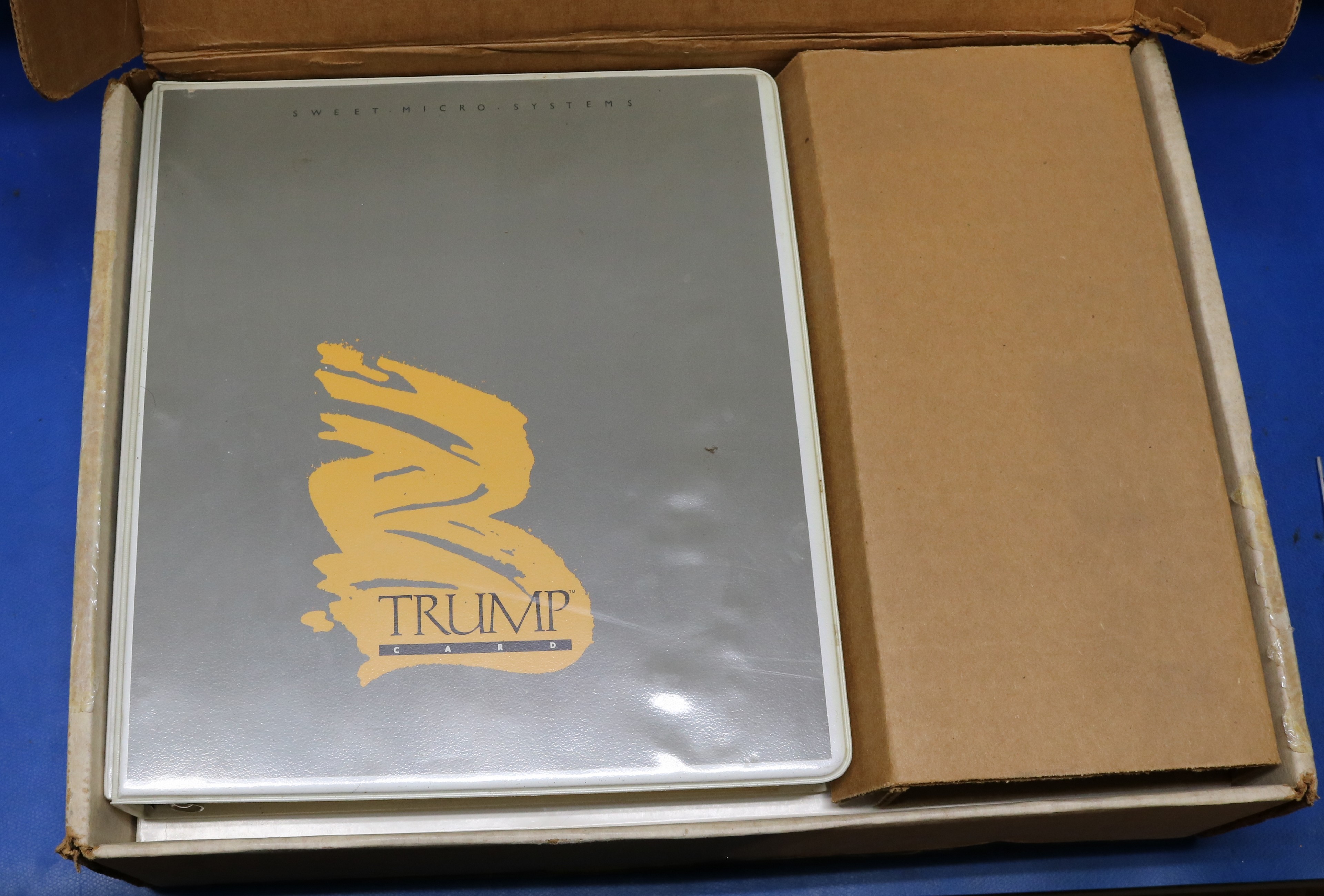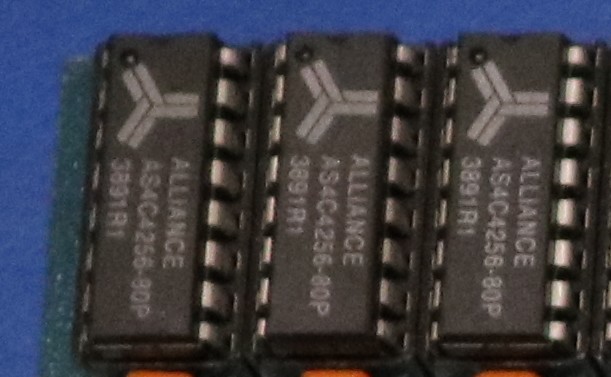In this blog post, I examine “The Trump Card”, a Zilog Z8000 coprocessor card that I bought on ebay:
The software has been found!!
Thanks to one of our readers/viewers, the lost Trump Card software has been found! In the first video, I lamented the loss of the software and the inability to use the card. I searched all the usual places, even having a few helpful chats with Steve Ciarcia, but we had no luck findign the software. Then about 6 months later, Hank approached me a member, Hank, came forward and let me know that he had found a couple of Trump Card disks. In the first video above I explore the hardware a bit. In the second video I install the board and try it out!
Background
The Trump card appeared in a pair of BYTE Magazine articles by Steve Ciarcia, back in 1984. These articles described a 16-bit coprocessor card for the IBM PC, featuring a Zilog Z-8000 microprocessor, together with 512KB of memory and a small boot ROM to boot the card. This enabled the following features:
- TBASIC, a basic compiler that is mostly compatible with Microsoft’s BASICA.
- C Compiler
- Y multilevel-language compiler. This is described as being a structured assembler
- Various debuggers, editors, and other useful utility programs
- A CP/M-80 emulator
In addition to these executable programs that could be run on the card, there was also the ability to use the card’s RAM as a ramdisk in the host PC, for regular PC programs.
Building your own Trump Card
The Ciarcia article contains the schematics necessary for you to build your own Trump card. Ciarcia, being an excellent technical writer, takes you through the theory and operation of the card. It would be a relatively straightforward effort to build the hardware in modern times, probably with a few conveniences such as substituting a large static RAM for the 32 DRAM ICs, and replacing a plethora of 74XX logic with PLDs. We could probably get it down to a 2/3 length ISA card or if one really worked hard, maybe even a half length ISA card.
Once you built the card, the article instructs you to send a picture of your constructed Trump Card, along with $30 to Steve Ciarcia, and Steve would then send you the documentation and the software. It’s unclear how many people built their own Trump Cards. It would be a daunting task for a hobbyist to construct this large of a card back in 1984. Dedicated hobbyists would have been capable of this level of implementation from the article, but it would be easier to start with a kit. Sweet Micro Systems offered kits for $525 that included a pcboard with all sockets soldered, and including the EPROMs with the firmware.
Commercial Availability
The card was also commercialized by Sweet Micro Systems, who sold them for $995 with only 256K of RAM, or $1325 with a full 512K. Sweet Micro Systems is also well-known for producing other popular and unique expansion cards back in the day, such as the Mockingboard speech and sound board for the Apple II computer.
Obtaining my Trump Card
I had been looking for the software for some time when I noticed in late 2022 an eBay auction that appeared to contain a complete-in-box card, with its documentation. The seller had obtained the card from a storage unit auction. If you’re unfamiliar, storage rental companies will often auction the contents of a storage unit that is sufficiently delinquent on payment. There are multiple cable TV shows about the unique items that occasionally show up in these units.
Some back and forth with the seller led to the seller doing a thorough search of the box, and he determined that, sadly, no disks were included. The disks must have been separated from the contents by the previous owner, perhaps decades earlier. We negotiated a price, and the card made its way to me. A card without software, while not particularly useful, is better than no card at all!
Unboxing
Opening the box, you’re immediately greeted with the manual:

Removing the manual, there’s a smaller box beneath that contains the card:
[INSERT picture]
Taking a closer look at the card
Some pictures below:

Note that the RAM chips are not as described in the article. The article describes using 4164 DRAM ICs for a total of 512K. My board appears to have AS4C4256 ICs which is somewhat of an enigma. Casual searches for AS4C4256 bring up an Austin Semiconductor part that is a 256Kx4 DRAM, but this is clearly not that chip — a 44256 variant requires an additional 4 pins and is a 20-pin IC. These are clearly 16-pin ICs. My best guess would be that they are actually some type of 41256 variant, before the 44256 nomenclature became commonplace. That would make my board 2MB board. It does bear some investigation of the bodges to see if they are implementing an additional address line. I’m unsure if this was a factory configuration or a modification done by the previous owner.

There are numerous bodges (post-manufacturing modifications) made to the board, such as this IC with its pins bent upside-down:

Below is a picture of the underside of the board. Notices lots of additional reword. The tape holding the resistor is my doing; the resistor had been attached to one of the IC pads and had come loose.

Next Steps – Find the software
It’s apparent that the best way to use this expansion card would be to locate the original software for it. If the card can turn up in the inventory of a storage auction reseller in 2022, then surely the software disks could turn up too. The problem is that people might not realize the worth (not necessarily financial worth, but certainly historical worth) of such disks. If you find these disks, please let me know!
If the disks can be found, and rights to the software could be obtained (perhaps from Ciarcia himself) then retro-computing enthusiasts could start producing the cards again. Taking the schematics from the article and creating an Eagle or Kicad layout would be a straightboard exercise. Boards could then be easily ordered from the board house of one’s choice.
Backup plan – write new software
I am a computer programmer, and a fairly capable one. I’m capable of writing software for this card myself. What I would probably do is the following:
- Start with CP/M-8000 v1.1 as a base operating system, which I already have
- Replace the CP/M-8000 BIOS with routines the plumb console IO and disk IO through the interface to the host (IBM) PC.
- Write PC software to implement the host side of this communication
This would give us a card that would effectively be a CP/M-8000 coprocessor. However it falls short of what the product originally did — the basic compiler and CP/M-80 emulator are not something that I would attempt to reproduce myself as it would be too much of a time sync for something that is not commercially viable.
We Found It!
Here’s a screen shot of the software in action!

Hello,
I’ll give you a leg up…
The Intel 80386 & early 486 systems [non-IBM] (of the late 1980s) used 1 Meg 9 bit SIMM modules.
SIPP modules were rare and expensive, also not all that comparable due to copy write/patent infringement issues.
Using those memory chips you could easily adapt the SIMM socket(s) to your project or surface mount the chips directly to your project board.
I’m an old hardware specialist that actually used an Apple 3 (last gen prior to the Lisa). Oh, I also NEVER worked for Apple or IBM, so no conflict of interests on my side.
Best Wishes,
Anonymous
Hi,
I built a Trump card back then – wire-wrapped except the memory plane, based on the Byte article.
I sent a photo to Steve and received the binder and the software. I still have the card and the paperwork and I think I still have at least one floppy somewhere. I don’t recall how many floppies they sent me.
I was amazed by the speed, but I didn’t really use it for anything fancy, except as a fast ram-disk.
When the 286, 386 etc. became financially accessible with their larger memory space, the Trump card became more or less obsolete, but I kept it for sentimental reasons.
Good work !
Finn (France)
Steve told me that many people used it as a RAM disk, so you’re not alone 🙂 If you have pictures of the wire-wrapped card, I’d love to see them sometime. It must have been quite the project.
I have taken a few photos. Where can I deposit them ?
The reason I made the memory plane as a classic pc-board was that it was all straight lines. Easy to trace. I did, however, slant or skew the chips so as to have straight traces instead of wobbly ones.
I have just recently bought a Trumpcard off of ebay myself. Would anyone happen to know if the software for it is available for purchase or download anywhere? I haven’t had any luck so far in my search.